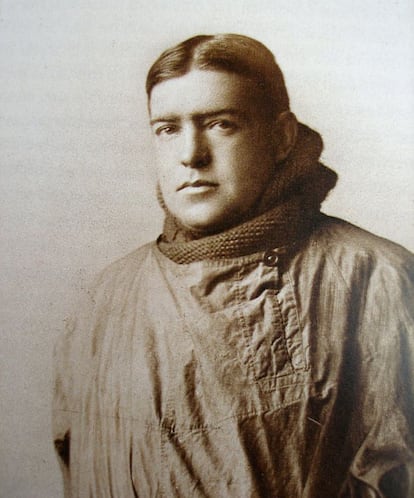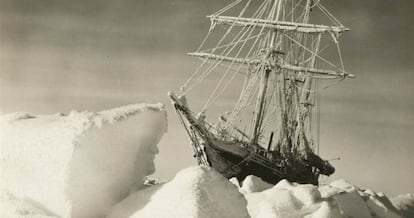The Endurance wasn't that tough: a study reveals Shackleton's famous ship lacked reinforcements to survive the ice.

Without a doubt, one of the most dramatic and symbolic images of the great, cold, and tragic adventure of the heroic conquest of the poles is that of the Endurance , the ship of Ernest Shackleton's legendary expedition to Antarctica, trapped in the ice pack in 1915 and transformed into an icy Golgotha before sinking. The striking photographs taken by Frank Hurley, a member of the expedition, including those taken during the polar night with the sailboat assaulted by the pressure of the ice and with its masts and rigging covered in a spectral white, represent like nothing else—except perhaps Captain Scott 's last refuge and his ill-fated departure—the adventure to the furthest reaches of the earth and the epic defeat.
Shackleton managed to save all his men by pulling them out of the frozen hell in what has been hailed as a sensational display of leadership and survival. The name Endurance (which means "endurance" in English) has come to epitomize that odyssey, in which men and ship battled tooth and nail against the elements to the very limits of their strength, and beyond. The Endurance , considered the strongest and most resilient polar ship of its time, would have sunk, according to the canonical tale, after a Homeric battle with the ice, and only the irresistible power of the forces of nature conspiring against the ship, tearing its rudder with an icy fist, would have been able to bring down its pride, its masts, and its flag before the cold jaws swallowed it.

However, a detailed scientific study by Finnish engineer Jukka Tuhkuri of Aalto University, published today, Monday, in the prestigious Polar Record, an academic journal on Arctic and Antarctic exploration and research that belongs to the Scott Polar Research Institute and is published by Cambridge University Press, states that the story is very different. After a thorough review of the documentation of the episode, including reading the journals of the expedition members and the copious existing bibliography, and carrying out a structural analysis of the ship and an exhaustive comparison with other polar vessels, Tuhuri concludes in his article "Why Did the Endurance Sank?" that the ship was not prepared for the task entrusted to it, adding that Shackleton knew this, which would place the responsibility for the disaster on the famed explorer due to his recklessness.
“The Endurance was not designed for the compressive conditions of the Antarctic ice pack, but rather for the easier conditions of the Arctic ice edge,” notes Tukhuri, who was one of 15 scientists who took part in the Endurance 22 expedition, which located the ship in its underwater grave at a depth of 3,000 meters in the Weddell Sea, the gateway to Antarctica, on March 5, 2022. The researcher was able to use the information provided by the wreck itself for his study. “The underwater images support the conclusions of this study,” he emphasizes.
According to the Finnish researcher, the Endurance was not exactly among the strongest ships of its time, and the weakest part of its hull was the engine room, which was not only much larger than on other Antarctic ships but also lacked beams to provide resistance against the compression of the ice. Shackleton, he claims, was aware of this weakness.
In December 1914, Shackleton, one of the most famous polar explorers of his time, set sail from Grytviken, South Georgia, on the Endurance, a three-masted, 300-ton, 43.9-meter-long Norwegian schooner launched in 1912 from the Framnaes shipyard in Sandefjord—which supplied ships for the poles—and originally named Polaris. The ship was built of English oak, North American elm, and Norway pine, and the explorer renamed it (which is notoriously unlucky) after his family motto: “Through endurance we shall prevail.” The plan of the Imperial Trans-Antarctic Expedition was, once the explorers had landed, to cross the white continent, the great adventure that remained after the conquest of the South Pole, from the Weddell Sea to the Ross Sea, where a support party would be waiting for them on another ship, the Aurora , to return them home.
As is well known, the mission failed: in January 1915, before reaching its destination of Vahsel Bay on the mainland, the Endurance became trapped with all sails set in the frozen sea and began to drift slowly outward, embedded in the ice. The ship was unable to withstand the force exerted by its white prison, which gradually tore it apart despite the crew's best efforts to free itself. In October, the expeditionaries abandoned ship and built a camp on the ice beside it while trying to extract as much useful material as possible. On November 21, the Endurance sank bow first ("It's going, boys!"), and an agonizing march on foot began, pulling lifeboats in search of open water so they could sail to some place where they could be rescued. After a truly icy ordeal, they reached the deserted Elephant Island, and from there Shackleton bravely sailed with a handful of his men until they could get help for everyone. The 28 passengers on board the Endurance were saved in what is considered one of the greatest survival feats of all time, making its leader a model of courage, selflessness, and positive leadership.

Tukhuri finds the whole story very good and exciting, but points out the fact that although the Transantarctic has been analyzed in great detail, including the life of the ship's cat (poor Mrs. Chippy ), no analysis of the ship has ever been done before, “which is surprising considering that the crushing of the Endurance and its structural strength played a central role in the fate of the expedition.”
Popular narratives about the Endurance have emphasized its durability, giving rise to the erroneous notion that it was the strongest wooden ship of its time, the researcher points out. But, of course, it's worth considering that the other most famous ship of polar exploration, Nansen and Amundsen's Fram , can be seen and even visited in the museum of the same name in Oslo, while to see and visit the Endurance you would have to dive 3,000 meters into the sea. Tukhuri also debunks the belief that the Endurance 's rudder was its Achilles' heel.
Using naval architecture parameters and complex calculations, Tuhkuri claims that the problem with the Endurance is that “it was designed and built for polar tourism, for hunting polar bears and walruses in the Arctic, in the Greenland Sea, Svalbard, or Novaya Zemlya during the polar summer,” but not to face the power of the Antarctic ice pack. Unused by its original owners, it was sold to Shackleton in March 1914. The researcher indicates that the explorer was aware of the ship’s drawbacks for his mission.
Analyzing the ice-crushing episodes that occurred between February and October 1915, Tuhkuri details how the situation escalated as terrifying noises occurred, and the ship seemed about to be reduced to pieces. The beginning of the end came with a tremendous creaking and a prolonged vibration throughout the hull, accompanied by the ghostly wail of eight emperor penguins who came to observe the scene. The Endurance began to take on water that the pumps could not bail out. The sound of the ice was "like pistol shots." They abandoned the ship on October 27, but it did not sink until November 21, so its agony could be documented.
The scholar recalls that the Endurance was the fourth exploration ship to enter the Weddell Sea. It was preceded by the Swedish Antartic in 1902, whose history is similar and which Shackleton knew well, having participated in the rescue and kept the log of that adventure on the Endurance ; the Scottish Scotia in 1903; and the German Deutschland in 1912. The latter two managed to escape the ice trap and return. Shackleton helped prepare the Deutschland and recommended adding diagonal beams for reinforcement. That was precisely what he failed to do on the Endurance, Tuhkuri emphasizes. “Why he didn't reinforce his ship in the same way is unknown,” he notes, adding that the explorer was well aware of the Endurance 's structural weaknesses. “In a letter to his wife, he confesses that it is not as robust as the Nimrod, the ship he used on his 1907-1909 expedition.” The researcher adds that John King Davis, one of the most experienced captains and who declined to go with Shackleton (the Endurace was commanded by Frank Worsley), expressed his doubts about the ship to the explorer. He felt that the modern engines, comfortable cabins, and excellent laboratories did not compensate for its structural weakness if it encountered the worst ice, unlike old and sturdy converted whaling ships like the Scotia, the Aurora , or the Nimrod.
Tuhkuri also compares the Endurance , unfavorably, with Adrien de Gerlache's Belgica —which commissioned the Polaris —Scott's Discovery , the Gauss , and the Fram . The latter two could withstand, he estimates, twice the force of ice pressure as the Endurance . It also couldn't retract its rudder and propellers like other polar ships, and any appendage is a hazard when trapped in the ice.
"The Endurance may have been strong and heroic in the poetic sense," the researcher summarizes in what sounds like an icy epitaph; "unfortunately, in the engineering sense, it wasn't."
EL PAÍS





